Biodex Gait Trainer 3
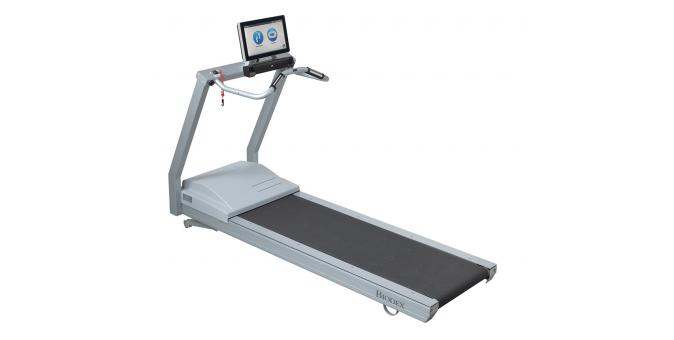
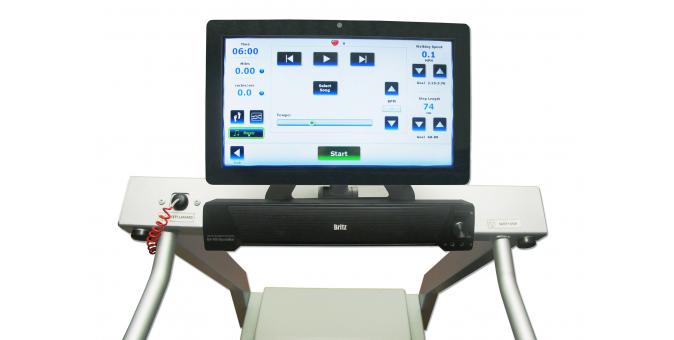
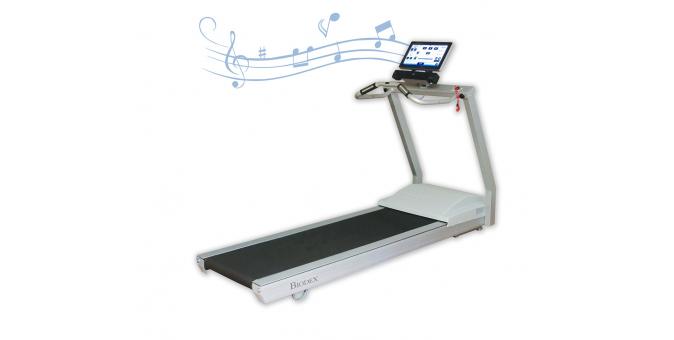
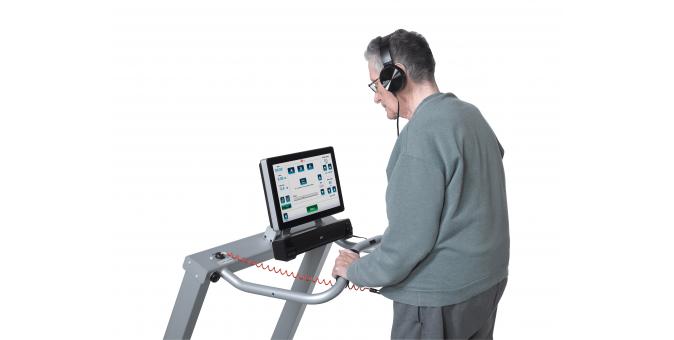
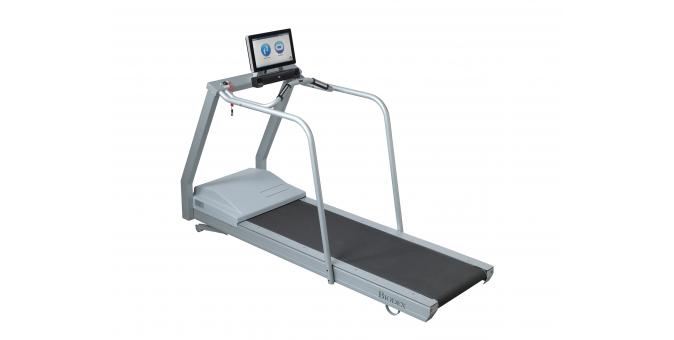
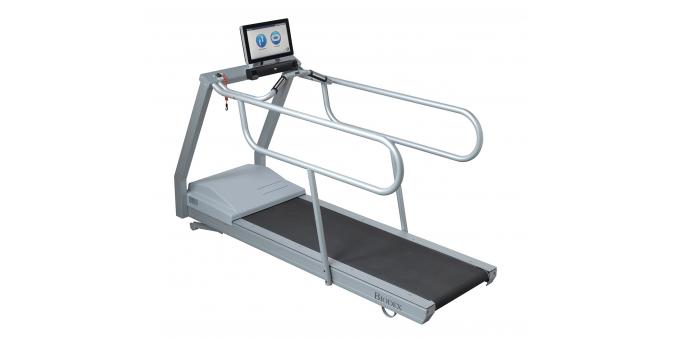
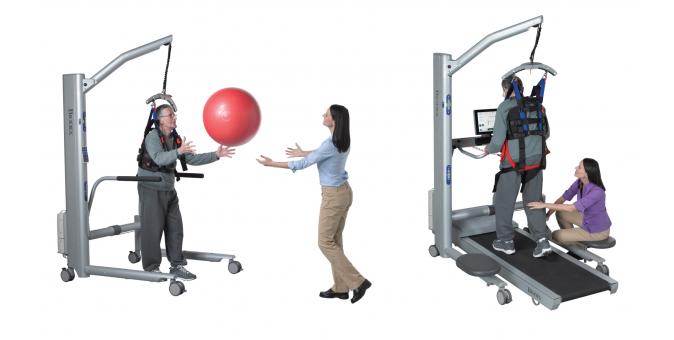
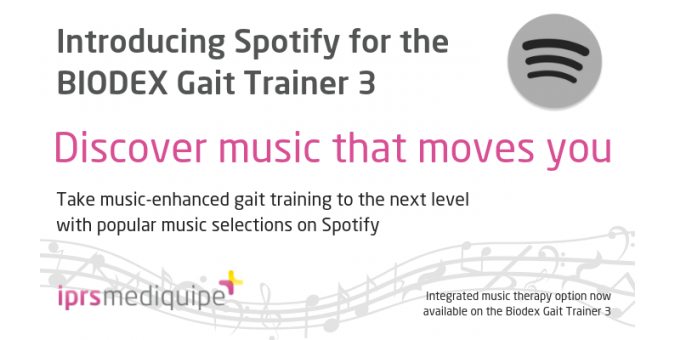
More than just a rehabilitation treadmill... It is the most important improvement to gait training since the parallel bars
The Gait Trainer 3 provides audio and visual biofeedback of step length and step speed
The Biodex Gait Trainer™ 3 is more than just a rehabilitation treadmill... it is designed with an instrumental deck that issues both audio and visual real-time biofeedback to prompt patients into their correct gait pattern. Gait analysis and gait rehabilitation at its best; step length, step speed and right-to-left time distribution (step symmetry) are directly addressed. Patient footfall is compared to desired footfall step after step, both on the display in real time and documented in an easy to read histogram.
The Biodex Gait Trainer 3 is quiet, non-intimidating and allows the therapist to get in there and treat their patients. Real goals are monitored and progress reported. Objective documentation, with comparison to age- and gender-based normative data, helps prove need and document outcomes to family, referring physicians and insurance providers.
The Biodex Gait Trainer 3, with or without the Unweighing System for BWSTT, is suitable for all rehabilitation pathologies. Biodex has recently published Body Weight Support Treadmill Training (BWSTT) with Transition to Over Ground Ambulation: A Clinical Guideline for the Treatment of Patients with Neurological Conditions using Biodex Unweighing System and Gait Trainer. The document classifies the neurologically involved patient, then steps the user through the various phases of recovery for profound, moderate and minimal neurological impairments.
The Gait Trainer 3 now has the option to add Integrated Music Therapy; Music Therapy is an evidence-based use of music in rehabilitation and medical settings to improve functional movement. It comes with a sound bar and integrated starter library of music therapy-informed compositions which use specifically chosen musical elements to facilitate proper gait patterns.
For more information or a quote, please contact us on 0870 756 3090 or complete our online enquiry form.
Music Therapy
NEW Integrated Music Therapy for the Biodex Gait Trainer 3
Sensory Enhanced Option includes Music Therapists in the Plan of Care
Rhythmic Auditory Cueing (RAC) is well researched for its efficacy with the relationship between music and healing dating back to early civilisations. Working in conjunction with The Center for Music Therapy, Austin, TX, Biodex offers an integrated starter library of music therapy-informed compositions for the Gait Trainer 3. These high-quality recordings use specifically chosen musical elements to facilitate proper gait patterns. Therapists can easily adjust tempo during treatment, incorporate their own songs onto the trainer, and download music onto a patient’s mobile device for home use. The right music, the correct beats per minute (bpm) and gait repetition help reinforce neuroplasticity and get patients better, faster. Documented.
Product No. 950-413 Integrated Music Therapy Package
Compatible with Biodex Gait Trainer 3 featuring Windows OS. Includes music library and sound bar.
In response to the strong, evidence-based value of Rhythmic Auditory Cueing (RAC) and sensory-enhance movement, Biodex brings Integrated Music Therapy to the Gait Trainer 3.
Music therapy is the use of music in rehabilitation and medical settings to improve functional movement, treating such conditions as:
- Parkinson’s disease
- Multiple Sclerosis
- Cerebral Palsy
- Stroke
- Traumatic Brain Injury
Music Therapy Brochure Download
Treat More Patients with Music Therapy
The current ratio of physical therapists to music therapists is 30 to 1. The increasing rate of Parkinson’s diagnosis alone reinforces the need for greater access and more effective tools for treatment. Integrating music therapy with the Gait Trainer 3 becomes an efficient rehabilitation tool that enables the music therapist to treat more patients on a broader scale. The value of music therapy can now be measured – prove faster outcomes with documented, quantitative reporting.
The Biodex Gait Trainer 3 is an Ideal Platform for Integrating Music Therapy
Music tempo, or beats-per minute (bpm), can be managed to influence certain gait characteristics. Walking, or gait cycle time, can be described as steps-per-minute (spm). Biodex Gait Trainer 3 has the capability to control belt speed (individual’s walking speed) in units of spm (gait cycle time).
While the repetition of gait training encourages neuroplasticity, music therapy-informed compositions in the correct beats per minute (bpm) elicit the desired gait pattern. The Gait Trainer includes a starter library of compositions and enables music therapists to incorporate their own. Music can also be transferred to a patient’s personal device to reinforce learning outside the clinical setting.
The Gait Trainer 3 provides real-time biofeedback and quantifiably displays step length, step speed (spm) and step symmetry. With the Music Therapy option, the Gait Trainer 3 serves as a platform for rehabilitative collaboration.
How Music Therapy Impacts Physical Rehabilitation
Those affected by debilitating neuropathologies such as Parkinson’s, Stroke, Cerebral Palsy, and TBI will respond favorably to Rhythmic Auditory Cueing (RAC). When music carefully chosen for this purpose is applied by a therapist, the brain’s plasticity is enhanced, reorganising neuropathways to relax and/or induce muscles for movement. Fitting the music to patient synchronises gait for sensory-enhanced movement.
Walking can be aligned with Rhythmic Auditory Cueing (RAC) to improve step length, step speed (velocity) and step symmetry (left/right side deviations). The Qualitative component of what is done musically is quantified and documented by the system’s computer. The pre-test, comparison to normative data, and post test results are presented in scientific data; the songs, beats per minute, the dates and progress are now part of the treatment conversation, giving music therapists a greater voice in the plan of care.
Clinical Application
Biodex provides a manual and eLearning instructional videos to help choose which compositions are best suited for various clinical categories, for example:
Neurologic Diagnosis:
- Extreme gait impairment
- Moderate to severe gait impairment coupled with cognitive impairment
Orthopaedic Diagnosis:
- No cognitive impairment
Music Library
The Music Therapy option for the Biodex Gait Trainer 3 is accessed via USB flash drive that activates the music player software. A library of music therapy-informed compositions, as well as various metronome beats and tones are offered. Sound bar and bracket includes input for headphones and microphone.
Recorded Among Top Performers
Biodex Music Library contains recordings produced at historic and internationally renowned studios, known for high commitment to sound integrity and technological excellence. Locations include Premier Studios, New York City, NY, (where industry artists such as Madonna recorded “Erotica”) and Bismeaux Studio, Austin, TX, which has seen the likes of Ray Benson and Asleep at the Wheel, Willie Nelson, George Strait and many others.
Silvery Moon Medley© is a music therapy arrangement that has a clear, complementary playback structure for walking patterns. Available in tempo ranges from 90-140 bpm.
Street Walking© is an original music therapy-informed composition provided at two different tempos between 60- and 140 bpm, each with a different arrangement, and geared toward specific movement needs. The composition provides a clear, complementary playback structure for walking patterns that are well below normal gait ranges.
Animals Everywhere© is an original music therapy-informed composition provided at five different tempos between 45- and 130 bpm, each with a different arrangement and geared toward initiation and continuation of gait at extremely impaired levels of steps per minute or beats per minute.
These songs are in 4/4-time signature, with distinct, consistent down beat, without the confusion of non-complementary instrumentation for gait training. Street Walking© and Animals Everywhere© were recorded in DXD format as is used in SACD, (Super Audio CD) for Full Analogue Bandwidth.
Additional non-music therapy-informed compositions of various genres and tempos, as well as a wide range of metronome tempos and sounds are available in the Biodex Music Library.
Silvery Moon Medley© is an original arrangement from The Centre for Music Therapy, Inc. Street Walking© and Animals Everywhere© are original compositions from The Centre for Music Therapy, Inc.
Applications
Goal: Develop symmetrical gait by improving step length, step speed and right to left time distribution
Gait Analysis, gait trainer, rehabilitation treadmill, gait rehabilitation for...
- Older Adult Patients
- Orthopaedic Patients
- Stroke/Traumatic Brain Injury
- Spinal Cord Injury
- Amputation of Lower Extremity
- Parkinson’s Disease
- Patients with Neurological Involvement
- Vestibular Patients
– Audio and visual biofeedback prompts patients into a proper gait pattern
– Develops balance and coordination
– Develops strength and range of motion
– Increases cardiovascular capacity and endurance
– Provides a safe environment for patients and therapists
– Documents important gait parameters
Older Adult Patients
Method: Have the patient walk at a comfortable step speed concentrating on symmetry of step length and step time. Once the patient has developed symmetry and cardiovascular gains, begin to work towards normative gait parameters. As an option, support the patient in the Biodex Unweighing System to provide a no-fall environment.
Results and Benefits:
- Improved patient confidence with associated improvements of strength, balance and endurance.
- Excellent for older adults to perform physical conditioning exercises associated with rehabilitation or fall prevention programme.
- Reduction in disuse atrophy effective.
- Efficient and safe use of clinician
When combined with the Unweighing System:
Allows concentration on treatment, not physically supporting the patient.
Orthopaedic Patients
Method: Utilise audio and visual cues to develop step length symmetry and right to left time distribution. Initially support patient's body weight using the Biodex Unweighing System. Set belt in reverse direction (retro-walking) to assist with gains in range of motion. Forward direction of belt to work on symmetry of step length and step time.
Results and Benefits:
- Initiate rehabilitation earlier following joint sprains, surgical repair or replacement.
- Gains in range of motion, gait parameters, strength and endurance.
- Treadmill training effects are readily transferred to improved over ground walking speed and endurance.
- Effective, efficient and safe use of clinician time.
When combined with the Unweighing System:
- Rehabilitation can commence earlier as the Unweighing System provides a safe environment for both the patient and the clinician
- Improved proprioception and acceptance for weight bearing activity.
- Allows concentration on treatment, not physically supporting the patient.
Stroke/Traumatic Brain Injury
Method: Progressively address step speed and right to left time distribution. Use a slow initial belt speed (.10 cycles/sec - .50 cycles/sec). Clinician may assist with paretic limb placement to initiate step length. Visual cues are used initially to reinforce step length. Once step symmetry is reached, gait speed can be addressed.
Results and Benefits:
- The Gait Trainer forces the patient to focus on foot placement, which is reinforced through visual cues on the display. (Please hyperlink to the Gait Trainer 3 product page)
- Improved right to left time distribution and increased step time during ambulation is achieved in an upright and fully supported position through repetitive and rhythmic movements.
- Treadmill training effects are readily transferred to improved over ground walking speed and endurance.
When combined with the Unweighing System:
- Rehabilitation can commence earlier as the Unweighing System provides a safe environment for both the patient and the clinician. (Please hyperlink to unweighing product page)
- Allows concentration on treatment, not physically supporting the patient.
Spinal Cord Injury
Method: Initially, concentrate on developing step length symmetry. Once symmetry is achieved, increase speed of the treadmill for progression towards normative gait parameters specific to the age, gender and leg length of the patient.
Results and Benefits:
- The Gait Trainer forces the patient to focus on foot placement, which is reinforced through visual cues on the display.
- Sensory input from the rhythmic treadmill belt movement assists with patterning of the central nervous system.
When combined with the Unweighing System: Rehabilitation can commence earlier as the Unweighing System provides a safe environment for both the patient and the clinician. Improved right to left time distribution and increased step cycles/sec during ambulation is achieved in an upright and fully supported position through repetitive and rhythmic movements. Allows concentration on treatment, not physically supporting the patient.
Amputation of a Lower Extremity
Method: Using audio and visual cues, initially concentrate on developing step length symmetry with focus on right to left time distribution. Once symmetry is achieved, increase speed of the treadmill for progression towards normative gait parameters specific of the age, gender and leg length of the patient.
Results and Benefits:
- The Gait Trainer forces the patient to focus on foot placement symmetry, which is reinforced through visual cues on the display.
- Efficient gait pattern with step length symmetry and improve right to left time distribution will reduce the metabolic demands associated with prosthetic gait.
- Goals can be set through comparison of the uninvolved and involved limbs performance measures.
Parkinson's Disease
Method: Utilise audio and visual cues to assist the retraining of the temporal and spatial deficits associated with Parkinsonian Gait. The patient focuses on the visual and audio cues, which help to regulate step length.
Results and Benefits:
- The Gait Trainer forces the patient to focus on foot placement symmetry, which is reinforced through visual cues on the display.
- Improvement of step length and step time.
- Improvement of muscular strength and endurance and overall cardiovascular tolerance for physical activity.
- Improved step symmetry and increased step time during ambulation is achieved in an upright and fully supported position through repetitive and rhythmic movements.
- Treadmill training effects are readily transferred to improved over-ground walking speed and endurance.
When combined with the Unweighing System: Rehabilitation can commence earlier as the Unweighing System provides a safe environment for both the patient and the clinician allowing concentration on treatment, not physically supporting the patient.
References
American Geriatrics Society, British Geriatrics Society and American Academy of Orthopedic Surgeons Panel on Falls Prevention, Guideline for the Prevention of Falls in Older Persons, April 5, 2001.
Cress ME, Buchner DM, Questad KA, Essel PC, daLateur BJ, Schwartz RS. Continuous-scale physical functional performance in healthy older adults: a validation study. Arch Phys Med Rehabil 1996; 77:1234-50
Simpson JM, Harrington R, Marsh N., Guidelines for Managing Falls Among Elderly People. Physiotherapy, 84:4;173-177 April 1998.
Wolfson L. Whipple R, Amerman P, Tobin JN. Gait Assessment in the Elderly: A Gait Abnormality Rating Scale and its Relation to Falls. J of Gerontology 1990; 45:M12-19
American Geriatrics Society, British Geriatrics Society and American Academy of Orthopedic Surgeons Panel on Falls Prevention, Guideline for the Prevention of Falls in Older Persons, April 5, 2001.
Cress ME, Buchner DM, Questad KA, Essel PC, daLateur BJ, Schwartz RS. Continuous-scale physical functional performance in healthy older adults: a validation study. Arch Phys Med Rehabil 1996; 77:1234-50
Barbeau, et al., Walking After Spinal Cord Injury: Control and Recovery
Gardner et al., Partial Body Weight Support with Treadmill Locomotion
Visintin et al., A New Approach to Retrain Gait in Stroke Patients Through Body Weight Support and Treadmill Stimulation
Suzuki et al., Determinants and predictors of the maximum walking speed during computer assisted gait training in hemiparetic stroke patients.
Suzuki et al., Relationship between stride length and walking rate in gait training for hemiparetic stroke patients
Barbeau et al., Walking After Spinal Cord Injury: Control and Recovery
Gardner et al., Partial Body Weight Support With Treadmill Locomotion...
Visintin et al., A New Approach to Retrain Gait In Stroke Patients Through Body Weight Support and Treadmill Stimulation
Suzuki et al., Determinants and predictors of the maximum walking speed during computer assisted gait training in hemi paretic stroke patients.
Suzuki et al., Relationship between stride length and walking rate in gait training for hemi paretic stroke patients.
Peterson et al., Physiological responses during unweighted ambulation of three patients with below the knee amputation: A pilot study.
Morris et al., Stride Length Regulation in Parkinson's Disease
Features
- Instrumented Deck – Gait Trainer™ 3 is the only treadmill with an instrumented deck that monitors and records step length, step speed and right-to-left time distribution (step symmetry).
- Open Platform – enables patient access for therapist interaction; easily accommodates BWSTT with the Biodex Unweighing System.
- NEW Windows Operating System and Larger Display – intuitive navigation, large touch-screen display (15.6”) for improved user interface. Can also accommodate external keyboard and a mouse.
- Audio and Visual Biofeedback – motivates patients with real-time biofeedback, prompting proper gait patterns. Biofeedback helps patients stay on target in each phase of rehabilitation.
- NEW Integrated Music Therapy – Rhythmic Auditory Cueing (RAC) is available with optional music therapy-informed compositions. High-quality recordings use specific musical components and correct beats per minute to enhance gait patterns and encourage neuroplasticity. Biodex technology documents results of music-supported therapy.
- NEW Microsoft SQL Relational Database – allows you to easily store and retrieve patient data, multiple tests per patient. Export to Excel® for reporting and analytics.
- Objective Documentation – lets you quantify patient progress and demonstrate the benefits of treatment. Biodex technology helps accelerate positive patient outcomes, and then lets you prove it.
- Enhanced Normative Data – robust base of healthy population by age and gender for comparative patient assessment.
- Heart Rate Monitoring – Polar® contact handgrips (telemetry compatible) ensures proper training intensity.
- Connect & Engage – system allows connection to larger monitors or LCD projectors to enhance interaction for visually impaired patients.
Prove Need. Progress. Outcome.
All test results and training sessions can be stored and printed. Comparison to normative data helps communicate need, progress and outcome.
Unweighing System
Gait Trainer 3 and Unweighing

The Biodex Gait Training System
The Gait Trainer provides audio and visual biofeedback of step length and step speed. The Unweighing Support System provides assistance, helping patients regain their confidence, their strength and their stride. The Unweighing System, combined with the Gait Trainer 3 allows every patient the opportunity to get an early start on rehabilitation.
For more information, including current prices or to place an order, please contact us 0870 756 3090
Specifications
- Dimensions: 86" l x 27" w (218 x 69 cm)
Walking Area: 64" l x 20" w (160 x 51 cm)
Printer Stand: 24" l x 24" w (61 x 61 cm) - Deck: 1" thick (2.5 cm) reversible Teflon™ impregnated high-density composite fiber
- Motor: 2 HP with 4Q-Pulse Width Modulation Control
- Speed Range:
Forward: 0-10 mph (0-16 km/h)
Reverse: 0-3 mph (0-4.8 km/h) in 0.1 mph (.16 km/h) increments
Gait Trainer Mode: Speed limited to 3 mph (4.8 km/h) - Elevation: 0-15% Grade
- Heart Rate Monitoring: Polar® contact handgrips (telemetry compatible)
- Display: 15.6" (39.624 cm) All-in-One PC
- Printer: HP DeskJet
- Power: 230 VAC, 50/60 Hz
- User Capacity: 400 lb (182 kg)
- Weight: 395 lb (179 kg)
Certification:
- ETL listed to UL 60601-1 and CAN/CSA C22.2 No.:601.1.M90. CE conformity to EN 60601-1, EMC compliance to EN 60601-1-2.
![]()
Warranty:
- Two-years parts; one-year labour
Literature
- Download Gait Trainer™ brochure
- Download Integrated Music Therapy brochure
- Watch video – Integrated Music Therapy for Gait Trainer™ 3
- Watch video - Gait Trainer™ 3 for Parkinson's
- Download research – Music based interventions in Neuro Rehabilitation
- Parkinson's - Treatment of Patients with Parkinson's Disease using Biodex Technology
- Stroke rehabilitation - world-leading equipment for measurable results in gait, balance & strength
- Watch more videos - visit our YouTube playlist for Biodex Gait Trainer™ 3
Models
950-401 Gait Trainer™ 3 – Includes support bar
950-403 Gait Trainer™ 3 – Includes Extended Handrails
950-407 Gait Trainer™ 3 – Includes Geriatric/Pediatric Handrails
Optional: 950-413 Integrated Music Therapy Package
Compatible with Biodex Gait Trainer™ 3 featuring Windows OS. Includes music therapy and sound bar.
For more information or a quote, please contact us on 0870 756 3090 or complete our online enquiry form.
